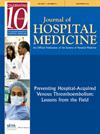Clinical features of suspected and unsuspected fatal pulmonary emboli in hospitalized patients
Abstract
Background
Pulmonary embolism (PE) is often unsuspected by treating clinicians. Since the adoption of clinical prediction scores for PE and the widespread availability of computed tomography (CT)-pulmonary angiogram, there are few reports of clinical presentations of hospitalized patients who died of PE.
Objectives
To compare the clinical signs, symptoms, and comorbidities of hospitalized patients who died of PE for whom PE was suspected versus not suspected antemortem.
Study Design and Methods
Case–control study from January 1999 to December 2018 in one Veterans Affairs (VA) hospital. We compared groups to examine differences in clinical presentations of fatal PE over the two decades.
Results
Among 1345 autopsies performed during the study period, 52 patients (4%) with fatal PE were included in the final analyses. PE was unsuspected before death in 29/52 patients (56%). Comparing groups, there were significant differences for: dyspnea (suspected 91%; unsuspected: 59%, p = 0.01); active malignancy (suspected 74%; unsuspected: 28%, p = 0.002); and atrioventricular (AV) nodal blocking treatment (suspected: 62%; unsuspected 30%,p= 0.03). A greater proportion of patients with unsuspected PE lacked symptoms of PE (suspected 0%; unsuspected: 31%, p = 0.003).
Conclusions
Fatal PE remains a common, unsuspected cause of inpatient death in the modern era. Symptoms of PE, active malignancy, and potentially confounding AV nodal blocking treatment were less frequent in patients with unsuspected PE. These data highlight the variation in presentation and the challenge of making the diagnosis in many hospitalized patients, particularly those without typical symptoms.


 求助内容:
求助内容: 应助结果提醒方式:
应助结果提醒方式:


